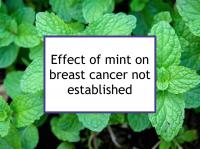Peppermint (Mentha piperita) and spearmint (Mentha spicata) are closely-related members of the mint family that incorporate similar compounds. Peppermint has less iron and more beta-carotene and vitamin C than spearmint. Unless otherwise noted, "mint" refers to peppermint in the discussion below.
Mint contains numerous volatile organic compounds and other components that have powerful antioxidant, antibacterial, antiviral, antimicrobial, and antifungal properties. Mint has traditionally been used with varying degrees of success in treating a variety of conditions. These include loss of appetite, irritable bowel syndrome, gallstones, common cold, headache, bronchitis, sinusitis, and pulmonary tuberculosis. Please note that both mint essential oil and menthol are toxic when ingested.
Mint is an excellent source of rosmarinic acid and the chemically-related caffeic acid. Mint is also a source of vitamin A (through its beta-carotene content), calcium, hesperetin, iron, lutein, luteolin, and manganese, most of which have been found to have anti-cancer properties. Mint also contains some apigenin and ursolic acid.
Breast cancer-related effects of consuming mint
While mint compound rosmarinic acid has been shown to have anti-breast cancer effects, mint has hormonal effects that need further study.
Rosmarinic acid
Rosmarinic acid has been shown to inhibit proliferation and induce apoptosis (programmed cell death) of triple negative (ER-/PR-/HER2-) breast cancer cells. Rosmarinic acid has also been reported to reduce the viability and migration of triple negative breast cancer stem cells. In addition, rosmarinic acid has been shown to inhibit the migration of bone-homing breast cancer cells in a dose-dependent manner.
Rosmarinic acid has also been reported to reduce doxorubicin-induced cardiomyopathy (heart damage) without reducing its cytotoxic effects against hormone receptor positive ER+/PR+ breast cancer cells.
Hormonal effects of mint
Mint has been found to have hormonal effects at levels of consumption achievable by regularly drinking mint tea. Mint is thought to reduce libido according to some folk medicine traditions. Peppermint and spearmint have been found in several studies to have antiandrogenic effects in rats. For example, one study found that peppermint tea caused total testosterone levels to decline in male rats and to damage testicular tissue at high doses.
Another study reported that while mint alone did not exhibit significant estrogenic activity in rats, it enhanced the estrogenic effect of estradiol (E2) when administered concurrently. One study of hirsute Turkish women found that drinking spearmint tea reduced their hirsutism and resulted a significant decrease in free testosterone and increases in luteinizing hormone, follicle-stimulating hormone and estradiol.
We do not mean to overstate these hormonal effects. Women in Morocco who consume a great deal of mint tea tend to have low rates of breast cancer (which has been attributed to their low initial age of childbearing and non-Western diet, among other factors) and no large populations studies have been performed to assess the association between drinking mint tea and breast cancer. However, based on the very limited evidence available, it is possible that the combination of regular and frequent mint consumption and our estrogenic Western diet could contribute to increased breast cancer risk.
Mint during breast cancer treatment
Mint extracts have been shown to protect against radiation-induced damage in various types of mouse cells. This implies that mint also could potentially protect breast cancer cells from radiation treatment. However, some radioprotective foods have been shown not to interfere with the cytotoxic effects of radiotherapy against tumor cells. For example, turmeric has been demonstrated to be radioprotective while at the same time increasing the effectiveness of radiotherapy. No animal studies have been conducted concerning mint's effects during radiotherapy, so whether mint potentiates or interferes with radiation treatment is unclear.
Mint essential oil has been shown to interact with the cytochrome P450 3A4 (CYP3A4) enzyme (which oxidizes certain toxins and drugs in order to eliminate them from the body), indicating that it could interfere with tamoxifen treatment. Therefore, exposure to mint oil should be limited during such treatment.
While mint has been used in some healing traditions to combat nausea and vomiting, results concerning using mint to treat gastrointestinal side effects of chemotherapy have been mixed.
Additional comments
Mint has been used in various folk medicine traditions to induce abortion and has been shown to have an anti-implantation effect in rats. Regularly drinking mint tea instead of water has also been shown to cause uterine damage in laboratory rats.
Foods containing mint can promote reflux in some people with gastrointestinal reflux disease (GERD). Various cultivars of mint have been found to cause damage to the liver and brain at high dosages. Essential oil of any type of mint should not be ingested without medical supervision.
Sources of information provided in this webpage
The information above, which is updated continually as new research becomes available, has been developed based solely on the results of academic studies. Clicking on any of the underlined terms will take you to its tag or webpage, which contain more extensive information.
Below are links to 20 recent studies concerning this food and its components. For a more complete list of studies, please click on mint.
